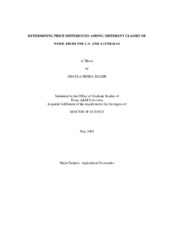| dc.description.abstract | The U.S. wool industry has long received lower prices for comparable wool types than those of Australia. In order to better understand such price differences, economic evaluations of both the U.S. and Australian wool markets were conducted. This research focused on two primary objectives. The first objective was to determine what price differences existed between the Australian and U.S. wool markets and measure that difference. The second objective was to calculate price differences attributable to wool characteristics, as well as those resulting from regional, seasonal, and yearly differences. In order to accomplish the objectives, the study was set up into three different hedonic pricing models: U.S., Australian, and combined. In the U.S. model, there were significant price differences in season, year, region, level of preparation, and wool description. In addition, average fiber diameter (AFD) had a negative nonlinear relationship with price and lot weight had a positive linear relationship with price. The Australian model was notably different than the U.S. model in that there were only three variables. The yearly variable follows the same general pattern as the U.S. data but with a smaller span of difference. The seasonal price differences were distinctly different than the U.S. because of the difference in seasonal patterns. In addition, the AFD had a similar negative nonlinear relationship with price. The final model combines both the U.S. data and the Australian data. The combined model had only three variables: season, year, AFD and country. As in the case of the previous two models, AFD had the same negative nonlinear relationship and similar price elasticity. Overall, there was a -30.5 percent discount for U.S. wool when compared to Australian wool. This can be attributed to several different factors. One of which is that the Australian wool industry has a more extensive marketing scheme when compared to the U.S wool market as a whole. However, this is only a beginning to future research that needs to be conducted. Continuing this study for future years, having more descriptive categories, and additional countries would further add explanation to wool prices. | en |


